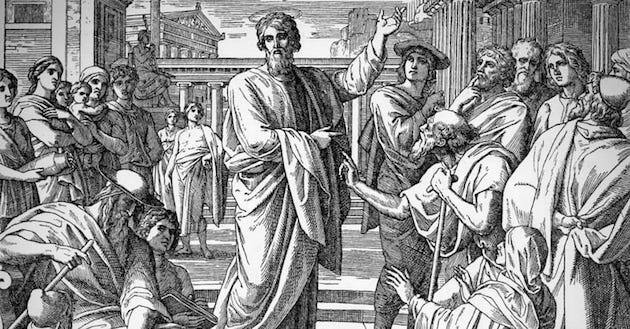As part of our history series, Metro Voice is publishing concise, easy-to-read articles on church history. Here’s our first installment on the history of Christianity.
THE APOSTOLIC AGE 30-100AD
The Strength of the Early Church
- They took the Gospel Everywhere. “First-century Christianity was a spiritual explosion ignited by the event in the presence of Jesus Christ, the church hurdled in all directions, geographic as well as social.” Bruce L. Shelley, Church History in Plain Language (Word: Waco, TX, 1982),
a.. It appealed to the masses by breaking down class barriers (Gal. 3:28).
b. The message centered on the gospel (Acts messages, 1 Cor. 15:3-4, Romans 1:16).
c. People voluntarily trusted in Christ as Savior. It was not socially acceptable to accept Christ and they were not coerced into doing it. (The Philippian Jailer Acts 16:31-34).
d.. People were willing to sacrifice everything for Christ. This proved the reality of their faith. - There was a total commitment of believers.
Christ was Lord and they followed even to their deaths and persevered in their witness. - There was a worldwide expansion of the Christian movement.
They were fulfilling the Great Commission in taking the gospel to the ends of the earth. The gospel crossed all cultural barriers. (Matt. 28: 19-20, Acts 1:8).
The Challenges of the Early Church
- There were a variety of false teachings and the need for doctrinal clarification.
The epistles addressed specific church problems and had specific messages for the churches through them. Romans and Galatians – Justification by Faith; 1st and 2nd Corinthians – Personal Morality and Integrity; Ephesians – Our Position in Christ; Philippians – Rejoicing in Adversity; Colossians – Who Jesus is; 1st and 2nd Thessalonians The Return of Christ; 1st and 2nd Timothy and Titus – How to lead a Church; Philemon – Forgiveness to others; Hebrews – What Jesus did and is doing today; James Faith proved by works; 1st, 2nd, and 3rd John – Trusting in the Real Jesus; Jude – Standing against false doctrine; Revelation – Comfort and future history.
A specific reference to combating false teaching, such as Gnosticism, is seen in 1 John 1:1-2; John wrote to counter the false doctrine of Docetism that Jesus was a ghost and not physically present.
This teaching was continued throughout the first few centuries. “Ignatius emphasized both Christ’s deity and Christ’s humanity.
There is only one physician, both flesh and spirit, born and unborn, God in man, true life and death, both from Mary and from God, the first subject to suffering and then beyond it, Jesus Christ our Lord.” (Ephesians 7:2 The writings of Ignatius).
Ignatius also believed that faith in the unity of God was another essential component of oneness in the Christian community . . . Ignatius’ emphasis on the importance of a common faith we also sense Paul’s words. Paul reminded the Ephesians Church of the “One Faith” (Ephesians 4:5). Jeffery Bingham, Pocket History of the Church (University Press; Downers Grove, Il 2002), 22-25. - There was a Second Generation who had not been with Jesus
These had not been with Jesus personally so they would naturally tend to be less excited than the first generation. With the beginning of persecution, is was a real test to see if they would be as dedicated as the apostles and their generation. - Imperial Persecution by Rome Intensified
The persecution after Pentecost was scattered compared to how Rome treated the Christians under Nero. Peter and Paul were both martyred for their faith, probably in Rome. Christians were used as a sport in the arena, singled out in society as antagonists, and ridiculed for their faith. Many believers had to go underground for fear of mass slaughter.
The dedication of early Christians
- They refused to worship Caesar.
These were some of the problems for Caesar and the Romans:
a. Truth against Error: They believed Caesar was a false God and to worship him would be heresy and to deny Christ.
b. Morality against Immorality; The worship of Cesar and acceptance of Roman culture involved many immoral practicesthat Christians refused to be trapped into participating in.
- They were willing to Die for their Faith.
The sacrifice and dedication of its followers was amazing. Many believers died in the Coliseum or at the hands of the Romans when Nero turned against them. Very few renounced their faith and burned incense to Caesar. They were willing to die as believers than to succumb to having their lives saved here by their worship of Caesar. - They brought a Christian Ethic into a Pagan Society.
Justin Martyr expressed the ethic this way. “Those who rejoiced in fornication now delight incontinence alone; those who made use of magic arts have dedicated themselves to the good and unbegotten God; we once took most pleasure in the means of increasing our wealth and property, now bring what we have into a common fund and share with everyone in need; we who hated and killed one another and would not associate with men of other tribes because of (their different) customs, now after the manifestation of Christ live together and pray for our enemies.”
–DanNelson








